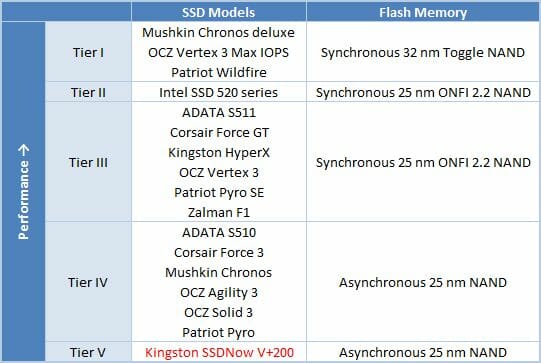Kingston SSDNow V+200 120 GB Solid State Drive Review

This inexpensive SandForce based SSD from Kingston not only turned out an unexpectedly unique product, but also demonstrated quite interesting performance results.
We have already tested several solid state drives from Kingston’s HyperX series and acknowledged them as one of the most successful implementations of the second-generation SandForce platform. But, like every other modern SSD with fast synchronous flash memory, the HyperX series is quite expensive, so Kingston also has more affordable products in its SSD model range. Today we are going to have a look at one of them – SSDNow V+200. Like the Hyper X series, this SATA III disk is based on a modern SandForce controller but its cheaper asynchronous NAND Flash memory makes it a more attractive option for cost-conscious customers.
For our tests we’ve taken an SSDNow V+200 of the most popular capacity of 120 gigabytes. We’ll check out how fast this SSD is and what benefits other than speed such a renowned SSD maker as Kingston can offer us.
Closer Look at Kingston SSDNow V+200 120GB
As usual, packaging comes first. Our Kingston SSDNow V+200 120GB was shipped in the Performance Upgrade Kit version as a rather large and heavy box. The box looks eye-catching, but the manufacturer doesn’t use it to tout product specs. We can only see a stylized picture of the SSD and some general information about it.
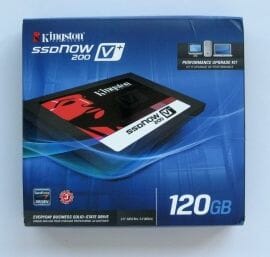
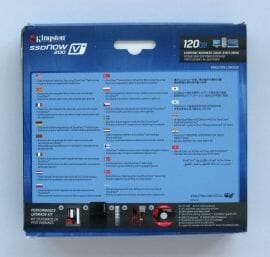
Besides other things, we can learn what the mentioned Performance Upgrade Kit consists of: quite a lot of useful accessories.

There are but few manufacturers who indulge their customer with so many extras, and Kingston seems to be among the leaders in this respect. Besides the SSD, the box contains an adapter to install this 2.5-inch disk into a 3.5-inch bay, a SATA cable with a SATA power adapter, a CD with Acronis True Image HD, and an external USB 2.0 enclosure (with cable) for 2.5-inch devices. In other words, Kingston provides all the software and hardware necessary to migrate from an old hard disk to the newly bought SSD. And some of the accessories, e.g. the USB enclosure, may come in handy afterwards as well.
The SSD itself looks quite ordinary, yet we can note a certain style about its appearance. The case has rough powder coating that resembles asphalt and there’s a large and pretty label with basic product information on the face side. Take note of the additional 4-pin connector next to the SATA and power ones at the back of the case. The manufacturer doesn’t explain it, so it must be some engineering thing.
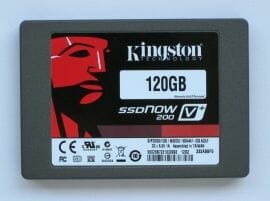
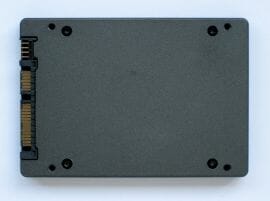
There are no other unique traits about the SSDNow V+200 120GB but we want to praise its quality of manufacturing. The halves of the case are neatly fitted together and there’s a layer of stiff heat-conductive material inside, between the PCB and the case.
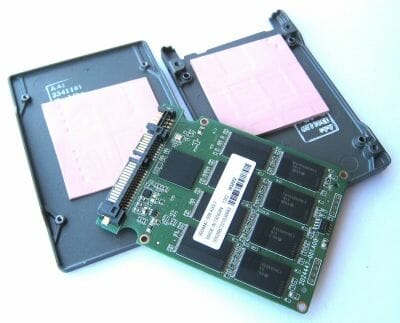
The interior is far more interesting because the combination of components we found on the PCB was nowhere near our expectations. Before opening the case up, we knew the SSDNow V+200 is based on an SF-2281 controller with asynchronous flash. This is indicated by its positioning and official specs which declare a sequential write speed of 480 MB/s as opposed to the HyperX series’ 510 MB/s. However, what we actually see next to the SandForce controller on the PCB are Intel’s NAND flash memory chips labeled 29F64G08ACME3.
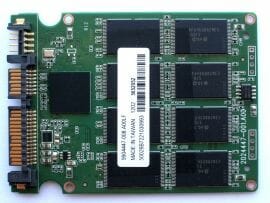
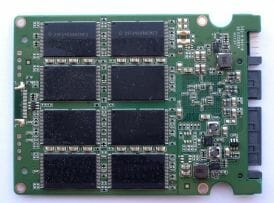
Each of these chips contains one 64-gigabit die of MLC flash memory manufactured on 25nm tech process and, according to the specs, has synchronous (!) ONFI 2.2 interface. We’ve seen such chips, for example, in the Zalman F1 120GB, a fast SandForce-based SSD but Kingston employs the same memory in its SSDNow V+200 120GB in the slower asynchronous mode. So, either these chips are defective and cannot work at high frequencies or Kingston’s SSDNow V+200 and HyperX series are only separated on the firmware level for marketing reasons. But if the latter supposition were true, the SSDNow V+200 wouldn’t cost much less than its HyperX counterpart.
There is one more oddity about the SSDNow V+200. We mean its firmware. The manufacturer’s website recommends using its new modification based on reference firmware version 5.0.1 which is the next big firmware update for the SF-2281 controller after version 3.3.2 that had previously solved the BSOD problem. However, Kingston seems to be the only maker of SandForce-based SSDs that recommends the new firmware to its users as yet. The rest of the manufacturers stick to version 3.3.2 because the newer version has been found to have some compatibility issues with SATA controllers other than Intel’s.
Kingston provides a special tool, SSD Toolbox, for managing its SSDs.

SSD Toolbox is limited in functionality compared to Intel or OCZ software that serves the same purpose. In fact, it cannot do anything save for showing product identification information and SMART attributes. You even have to use third-party utilities to perform a Secure Erase on your SSDNow V+200.
Winding up the descriptive part of this review, we want to show you the full specs of the Kingston SSDNow V+200 120GB:
- Controller: SandForce SF-2281;
- Interface: SATA 6 Gbps;
- Flash-memory: asynchronous 25 nm NAND;
- Size: 120 GB;
- Cache-memory: none;
- Sequential read speed: 535 MB/s;
- Sequential write speed: 480 MB/s;
- Random read speed ( 4 KB blocks): 85000 IOPS;
- Random write speed ( 4 KB blocks): 55000 IOPS.
Like most other SSD makers, Kingston provides a 3-year warranty. By the way, the service life of the SSDNow V+200 120GB is 76.8 terabytes of written data whereas the HyperX series model of the same capacity has a service life of 128 terabytes. The difference is due to the use of cheaper memory chips with a service life of 3000 rather than 5000 erase/program cycles. Besides, we shouldn’t forget that the SandForce controller’s RAISE technology with a 14% reserve pool of memory cells is going to let the SSD last longer.
Testbed Configuration
For our today’s SSD test session we put together a system on an Intel H67 based mainboard. This chipset provides support for two SATA 6 Gbit/s ports, which we use to connect the tested SSDs.
We are going to compare Kingston SSDNow V+200 120 GB against a few different SSDs with the same storage capacity, which are also based on SF-2281 controller. They are a typical SSD with 25 nm synchronous ONFI memory (Corsair Force Series GT – analogue to OCZ Vertex 3) and a typical SSD with 25 nm asynchronous memory (Corsair Force Series 3 – analogue to OCZ Agility 3).
Overall our testbed was configured as follows:
- Intel Core i5-2400 (Sandy Bridge, 4 cores, 3.1 GHz, EIST and Turbo Boost turned off);
- Foxconn H67S mainboard (BIOS A41F1P03);
- 2 x 2 GB DDR3-1333 SDRAM DIMM 9-9-9-24-1T;
- Crucial m4 256 GB system disk (CT256M4SSD2);
- Tested SSDs:
- Corsair Force 3 Series 120 GB (CSSD-F120GB3-BK, firmware version 1.3.3);
- Corsair Force GT Series 120 GB (CSSD-F120GBGT-BK, firmware version 1.3.3);
- Kingston SSDNow V+200 120 GB (SVP200S3/120G, firmware version 501).
- Microsoft Windows 7 SP1 Ultimate x64
- Drivers:
- Intel Chipset Driver 9.3.0.1019;
- Intel Graphics Media Accelerator Driver 15.22.54.2622;
- Intel Rapid Storage Technology 11.1.0.1006.
Performance
Random and Sequential Read/Write
We use CrystalDiskMark 3.0.1 benchmark to test the random- and sequential read and write speed. This benchmark is convenient to work with as it can measure the speed of an SSD with both incompressible random and fully compressible recurring data. This feature is important for testing SSDs based on SF-2281/2282 controller, which tries to compress the data before writing it into memory. So, there are two numbers in the diagrams below that reflect the maximum and minimum SSD speed. The real-life performance of an SSD is going to be in-between those two numbers depending on how effective the controller data compression is.
Note that the performance tests in this section refer to SSDs in their “Fresh Out-of-Box” state (FOB). No degradation could have taken place yet.
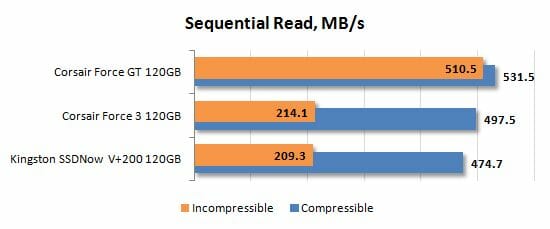
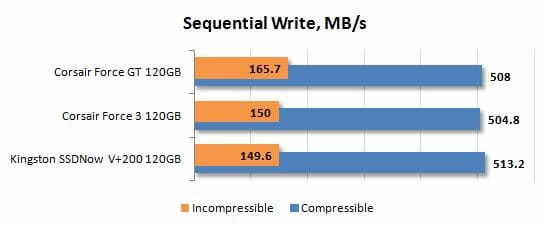
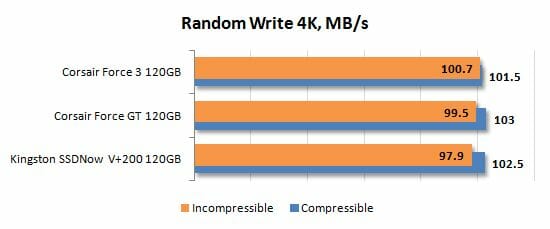
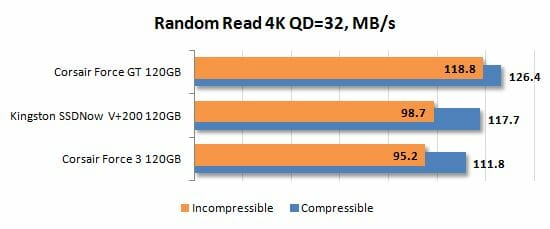
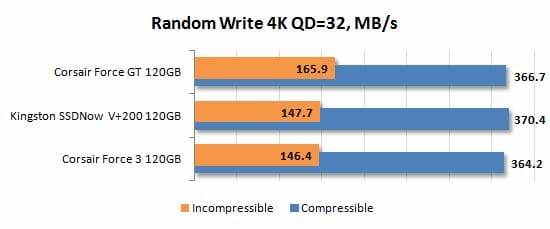
When it comes to SSDs with second-generation SandForce controllers, you can predict quite accurately what to expect from them in terms of performance after looking at what they have inside. The type of NAND flash memory is the decisive factor, as a rule, because all SandForce-based products come with almost the same firmware, except for identification data. We’ve only seen one exception so far: the Intel SSD 520 differs from others thanks to optimizations implemented by Intel programmers.
And now the Kingston SSDNow V+200 wants to be the second exception as it’s got NAND chips that are theoretically synchronous with ONFI interface but work in asynchronous mode. Moreover, they work in such a way as to make the SSDNow V+200 different from a typical SSD with true asynchronous flash memory. The difference is not for the better, unfortunately. We can see that especially clear when the SSD reads 4KB data blocks at a short request queue depth. Considering that this is a highly popular operation in real-life applications, the SSDNow V+200 may turn out to be rather slow by today’s standards. Let’s check it out in the other tests before jumping to conclusions, though.
Degradation and Steady-State Performance
Unfortunately, SSDs are not always as fast as in their “fresh” state. In most cases their performance goes down after some time and in real life we deal with completely different write speeds than what we see on the diagrams in the previous chapter of our review. The reason for this phenomenon is the following: as the SSD runs out of free pages in the flash memory, its controller has to clear memory page blocks before saving data into them, which causes substantial delays. Although, modern SSD controllers can alleviate the performance drop by erasing unused flash memory pages ahead of time, when idle. They use two techniques for that: idle-time garbage collection and TRIM.
Of course, users are more interested in the consistent performance of their SSDs over a long period of time rather than the peak speed they are going to see only during the initial short-term usage period, while the drive is still “fresh”. The SSD makers, however, declare the speed characteristics of “fresh” SSDs for marketing reasons. That’s why we decided to test the performance hit that occurs when a “fresh” SSD becomes a “steady” one.
To get a complete picture of SSD performance degradation we ran special tests based on the SNIA SSSI TWG PTS (Solid State Storage Performance Test Specification) methodology. The main idea of this approach is to measure write speed consecutively in four different cases. First we measure the “fresh” SSD speed. Then we measure the speed after the SSD has been fully filled with data twice. The third test occurs after a 30-minute break during which the controller can partially restore performance by running the idle-time garbage collection. And finally, we measure the speed after issuing a TRIM command.
We ran the tests in synthetic IOMeter 1.1.0 RC1 benchmark, where we measured random write speed when working with 4 KB data blocks aligned to flash memory pages at 32 requests queue depth. The test data were pseudo-random.
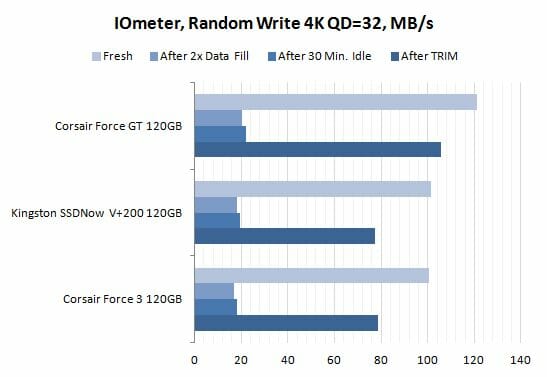
The Kingston SSDNow V+200 120GB behaves here just like any other SSD with second-generation SandForce controller. They do not do much background garbage collection, so their performance can only be restored by means of the TRIM command. Yet even TRIM can’t bring the SSD back to its original speed: the steady-state performance of the SSDNow V+200 120GB is going to be somewhat lower compared to its out-of-box state. This is limited to writing only, though. You can see the SSD’s write speed degradation in the next diagram, as measured with CrystalDiskMark 3.0.1 (we use random data in this test).



Interestingly, the out-of-box SSDNow V+200 120GB was about as fast as the same-capacity Corsair Force 3 but there is a large gap between them here. We used to consider the Force 3 among the slowest SandForce-based SSDs, but it is now more than 50% faster than the SSDNow V+200 when writing 4KB data blocks. Thus, the SSDNow V+200 is going to be slower than SSDs like ADATA S510, Corsair Force 3, OCZ Agility 3 or Patriot Pyro both at reading and writing.
Futuremark PCMark7
The popular PCMark 7 contains an individual disk subsystem benchmark. It is not a synthetic test, but is based on real-life applications. This benchmark reproduces typical disk usage scenarios and measures how fast they are completed in popular applications. Moreover, the disk access commands are not executed as a steady uninterrupted flow, but in a more realistic manner – with certain pauses caused by the need to process the data. The benchmark generates an overall disk subsystem performance rating as well as speed readings in MB/s in individual usage scenarios. Note that the absolute speed in these scenarios is not too high because of the above mentioned pauses between individual input/output operations. In other words, PCMark 7 shows you the speed of the disk subsystem from the application’s point of view. Numbers like that show us not only the pure performance of an SSD, but mostly how big of a performance gain a certain SSD can guarantee in real life.
We ran PCMark 7 on “steady” SSDs, which is what they are going to be in actual computer systems most of the time. Their performance in this case is affected not only by their controller or flash memory speed but also by the efficiency of their internal algorithms that fight performance degradation.

The PCMark 7 score is a good guide for people who don’t want to delve into technicalities but need a simple illustration of relative performance of SSDs in typical desktop applications. And we can see that PCMark 7 does not show an insurmountable gap between the typical Corsair Force 3 and the presumably slow Kingston SSDNow V+200. In other words, the sluggishness of the Kingston SSD shouldn’t show up much in real-life applications.
Now let’s check out the individual tests to get a more detailed picture of what our SSDs are capable of under various types of operational load:






As expected, the Kingston SSDNow V+200 120GB is somewhat slower than the Corsair Force 3 with asynchronous NAND flash and much slower than the Corsair Force GT which has synchronous flash.
Intel NAS Performance Toolkit
Intel NASPT is another disk sub-system test that uses real-life usage scenarios. Like PCMark 7, Intel NASPT reproduces predefined disk activity traces and measures how fast they are executed. However, the default traces are designed for network attached storage devices rather than for SSDs. Therefore during our test session we replace them with the specially developed SSD Benchmarking Suite which offers more relevant usage scenarios such as compressing and decompressing files, compiling large projects, copying files and folders, loading 3D game levels, installing software, batch-processing photos, searching a digital library for data, mass-launching applications, and transcoding video.
Like PCMark 7, this benchmark gives us a true-to-life illustration of disk subsystem performance. Here the SSDs are again tested in their “steady” state.

Intel NASPT is not as favorable towards the SSDNow V+200 120GB as PCMark 7: the Kingston is almost 7% slower than the Corsair Force 3 and 41% slower than the Corsair Force GT. The Kingston SSDNow V+200 is not a typical SandForce-based product with asynchronous memory, after all. It is not equivalent to such SSDs as Corsair Force 3, OCZ Agility 3, Patriot Pyro, etc.
The detailed INASPT results help us see what usage scenarios are the most suitable for our today’s testing participants. Take note that the data-transfer rate is higher than the SATA III interface bandwidth in some subtests. That’s because INASPT is a high-level test that uses standard Windows functions to access the disk subsystem. As a result, the OS caching mechanisms also affect the results.









The way the SSDNow V+200 120GB compares to a typical SSD with SF-2281 controller and asynchronous flash depends on the particular application and load. The difference can be negligible, for example when copying files and folders from the SSD, installing software or exporting photos. But there are also scenarios when the SSDNow V+200 is really slower than the Corsair Force 3: compilation of large programming projects, copying folders to the SSD, archiving and video transcoding.
File Copying Speed
We use AS SSD version 1.6.4237.30508 to benchmark the speed of copying files within a single partition the size of the whole SSD. The SSDs are tested in their steady state.



The Kingston SSDNow V+200 120GB comes through this test without obvious fails or wins. It has the last position in two out of the three diagrams but hardly differs from the Corsair Force 3 anyway.
Conclusion
When we received our sample of Kingston SSDNow V+200 120GB, we prepared ourselves to obtaining another set of not-very-high performance numbers typical of SandForce-based SSDs with asynchronous NAND flash, but our expectations never came true. The SSDNow V+200 turned out to be unique in a particular way.
First of all, it contains 25nm flash memory chips from Intel capable of working in synchronous mode but actually working in asynchronous mode. We couldn’t find out why and Kingston representatives didn’t give us a clear answer, either. It is supposed to be an element of their business strategy employed for marketing reasons.
Second, the SSDNow V+200 is somewhat slower than typical SandForce-based SSDs with asynchronous flash. It is especially slow when accessing random-address 4KB data blocks at a short request queue depth, which has a negative effect on its performance in many desktop applications. The SSDNow V+200 is an average 2-3% slower than reference-design SandForce-based SSDs in benchmarks simulating real-life loads. There are usage scenarios where this gap is as large as 10%.
So, the Kingston SSDNow V+200 120GB is a well-made product with excellent accessories and a renowned manufacturer’s tech support. The downside is that it is slower than such competitors as Corsair Force 3 or OCZ Agility 3.
Summing up all of our SSD-related tests, we keep on filling in our summary table where all SSDs are sorted into several groups according to their speed. There are now five such groups which differ greatly from each other, but the SSDs inside each group are almost identical in terms of performance.
